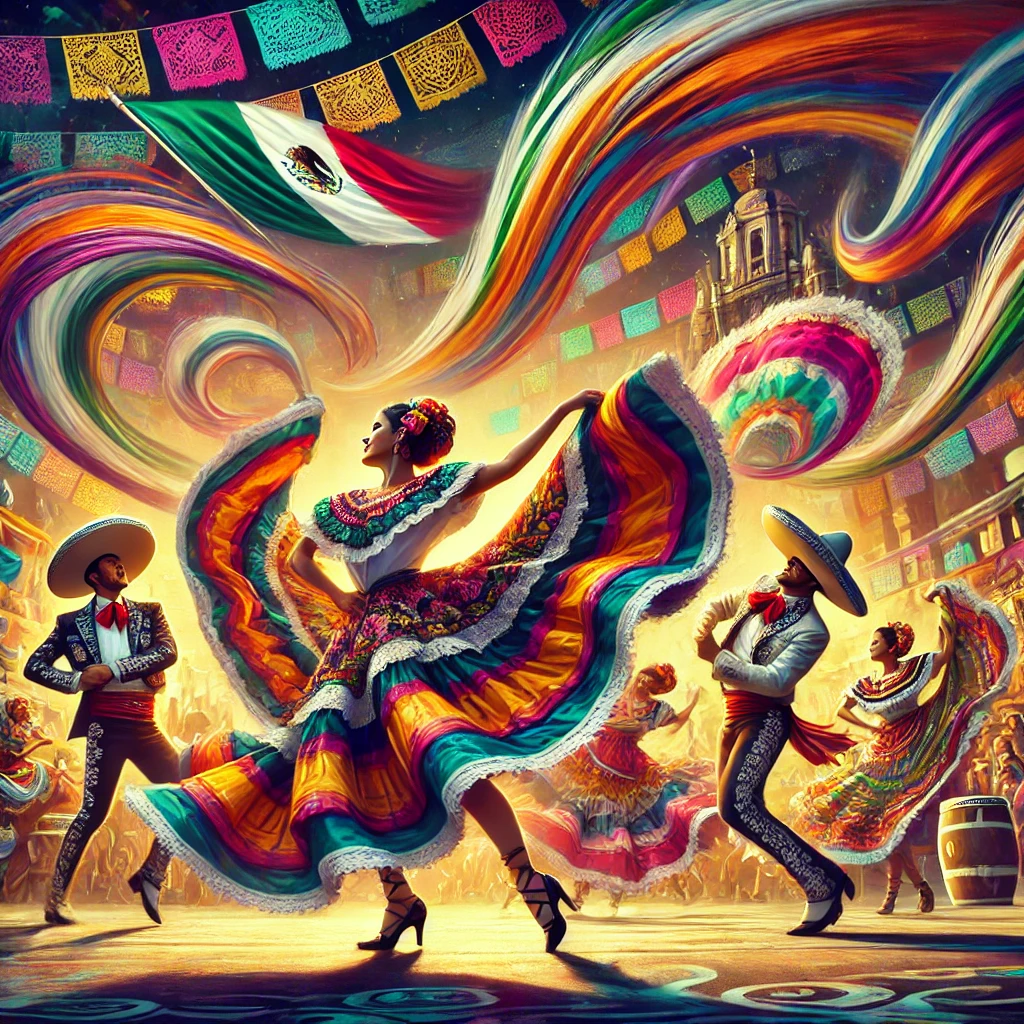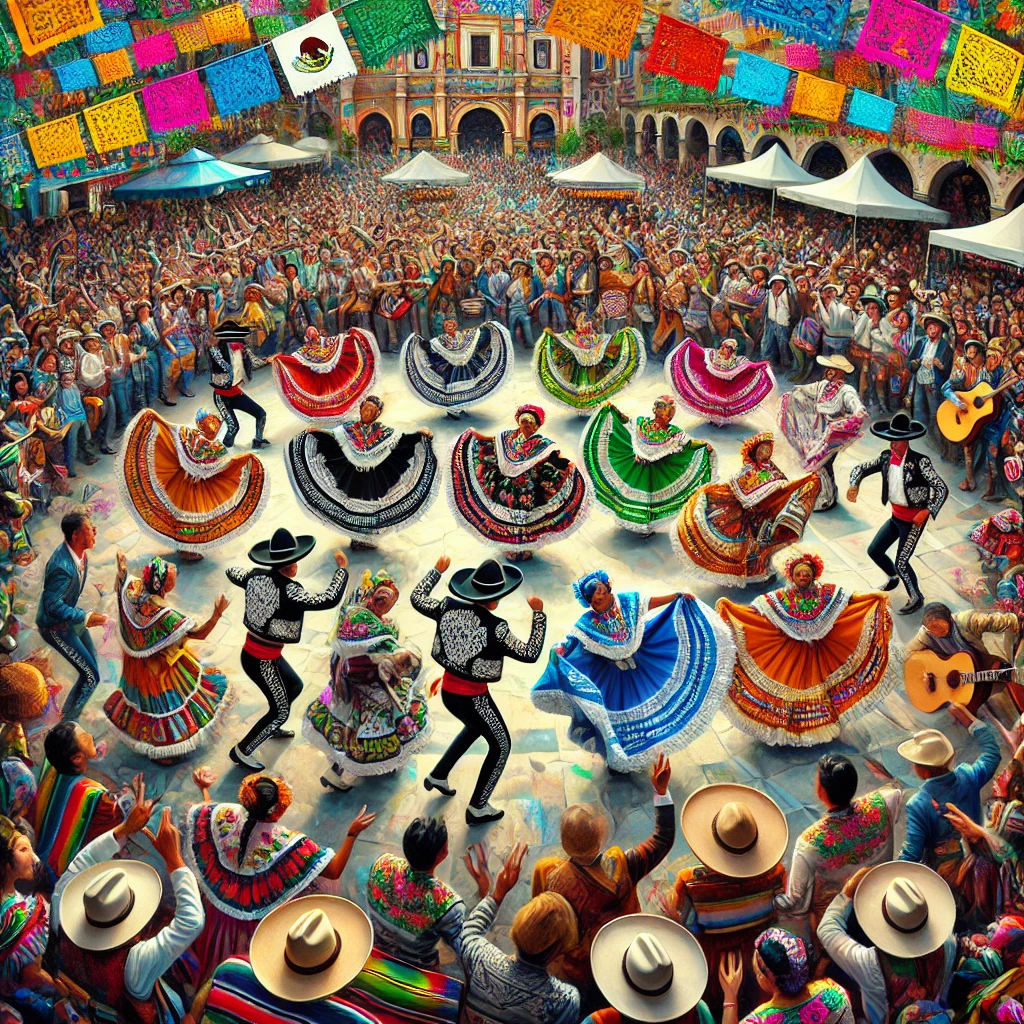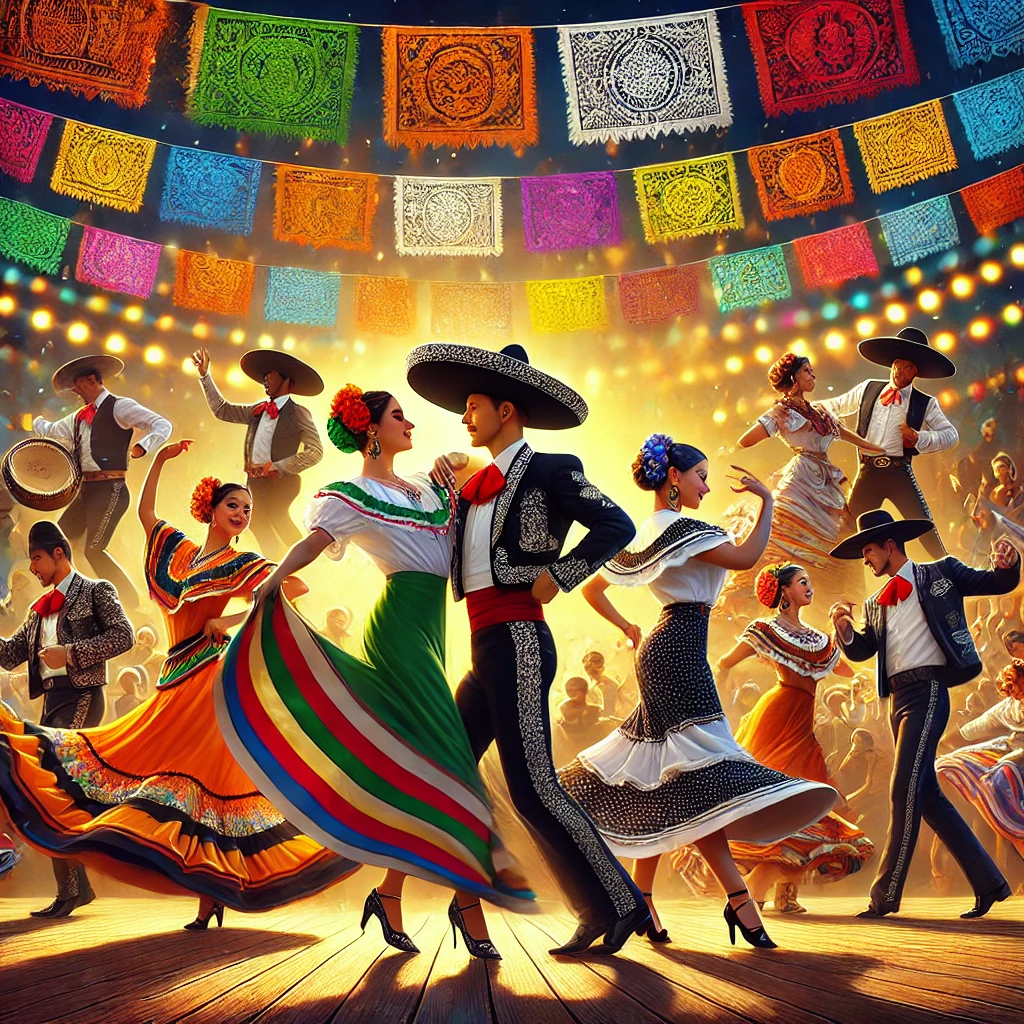Table of Contents
Introduction to Mexico’s Dance Culture
Mexico’s dance culture is a vibrant tapestry woven from centuries of history, tradition, and social expression. At the heart of this cultural phenomenon lies the deep-rooted belief that dance serves as a vital means of communication, capable of expressing emotions and narrating stories that transcend words. Each dance form, whether it be the rhythm of salsa or the grace of traditional folk dances, is a testament to the rich heritage and diverse influences that have come together to form Mexico’s unique identity.
The origins of dance in Mexico can be traced back to ancient civilizations where movement was intertwined with rituals and celebrations. The Aztecs and Mayans incorporated dance into their religious ceremonies, using it to honor the gods and mark significant life events. Over time, as colonization and globalization introduced new cultural elements, the Mexican dance landscape evolved significantly. The infusion of Spanish, Afro-Caribbean, and indigenous styles has led to a dynamic dance culture that is as varied as the country’s geographical regions.

Today, Mexico boasts a multitude of dance styles that reflect its diverse influences. Salsa, which has gained immense popularity, is deeply rooted in Afro-Cuban rhythms and has found a unique expression in Mexican society, where it often serves as a social activity that brings communities together. Conversely, traditional folk dances, such as Jarabe Tapatío and Danza de los Viejitos, celebrate regional heritage and are performed during festivities and cultural events. Both forms exemplify the significance of dance not just as artistic expression, but also as a vehicle for preserving cultural identity.
The importance of dance in Mexican culture extends beyond mere entertainment; it embodies a rich history and serves as a means to convey narratives that resonate with people’s experiences. Understanding Mexico’s dance culture provides valuable insights into the nation’s values, social dynamics, and artistic expressions, further enriching the overall appreciation of this dynamic art form.
The Historical Roots of Mexican Dance
Mexican dance has a rich and intricate history that reflects the diverse cultural tapestry of the nation. This evolution began with ancient indigenous communities, where dance played a pivotal role in religious and social ceremonies. Ritualistic movements were integral to these early societies, often serving as a medium for communication with deities and the natural world. For instance, the Aztecs and Mayans utilized dance to commemorate agricultural cycles, resulting in vibrant performances that honored their gods during harvest festivals and other significant events.
With the arrival of Spanish colonizers in the 16th century, significant transformations occurred in the realm of dance. The fusion of indigenous practices with European influences birthed new genres, weaving together traditional and colonial elements. Spanish ballroom dances introduced new rhythms and styles, which blended with local forms to create a unique Mexican identity. This change represented not only an adaptation but also a means of resistance, as indigenous communities preserved their cultural expressions amid colonization.
The impact of African, Caribbean, and other immigrant cultures further diversified the Mexican dance landscape. The rhythmic beats of Afro-Mexican music and dance forms, such as Son Jarocho, contributed to the evolution of popular dance styles still celebrated today. Regional variations emerged, reflecting local traditions and histories, while community celebrations became central to social cohesion. These dances did not merely entertain; they were instrumental in transmitting cultural heritage, embodying the stories, struggles, and triumphs of the people.
Throughout history, dance in Mexico has acted as a vital form of expression, intertwining various cultural threads into a rich tapestry. It is through understanding these historical roots that one can appreciate the depth and significance of Mexico’s dance culture, which continues to flourish in contemporary society.
Salsa: A Passionate Dance Genre
Salsa is a captivating dance genre that blends various cultural influences, creating an electrifying atmosphere and an essential form of expression. Originating in the Caribbean during the mid-20th century, salsa emerged primarily from Cuban son montuno and Afro-Caribbean rhythms. As it spread to the United States, particularly New York City, salsa evolved further, incorporating elements from jazz, rock, and other Latin dance forms. This rich fusion of styles has significantly contributed to the salsa phenomenon worldwide, making it a beloved choice among dance enthusiasts.
In Mexico, salsa has transformed into a vibrant and cherished component of the dance landscape. The genre’s energetic tempo, rhythmic footwork, and improvisational style resonate with Mexican dancers, allowing them to express their emotions and connect with others. Salsa dance events are widely celebrated across various regions of the country, particularly in urban centers where Latin music plays a central role in social gatherings. Dance schools and studios offer classes that cater to a range of skill levels, further nurturing the enthusiasm for this genre.
The community surrounding salsa in Mexico is both dynamic and inclusive. Enthusiasts take part in organized events such as salsa festivals, competitions, and social dances, fostering a sense of belonging and camaraderie among participants. Salsa not only serves as a source of entertainment but also plays a significant role in cultural exchange, encouraging individuals to embrace diversity while sharing their passion for dance. As salsa continues to evolve and adapt, its relevance in contemporary Mexican culture grows, underscoring its powerful influence on social interactions and cultural expressions.
Exploring Traditional Mexican Folk Dances
Traditional Mexican folk dances serve as a vibrant expression of the country’s rich cultural heritage, combining music, history, and intricate movements that capture the essence of community life and the Spanish indigenous fusion. Among the myriad styles of dance that originate from this diverse nation, two of the most notable forms are Jarabe Tapatío and La Bamba, both celebrated for their unique narratives and cultural significance.
The Jarabe Tapatío, often referred to as the Mexican Hat Dance, is perhaps the most recognized of all Mexican folk dances. It portrays the courtship between a man and a woman and is performed with lively music accompanied by colorful costumes. Traditionally, the male dancer wears a charro suit while the female dons a vibrant, flowing dress. The rhythm of the music, along with the steps of the dance, tells a story of romance and joy that resonates throughout the country. This dance is frequently performed during festivals and important celebrations, representing the spirit of Mexican national identity.
La Bamba, another iconic dance, is particularly well-known due to its infectious rhythm and the famous song that accompanies it. Originating from the coastal regions of Veracruz, La Bamba is not just a dance but a festive social event. The choreography involves energetic footwork and simple, syncopated movements that invite participation from everyone, reflecting the communal aspect of Mexican culture. Both Jarabe Tapatío and La Bamba are performed during significant festivities such as weddings, quinceañeras, and cultural festivals, creating an atmosphere of unity and celebration among participants. These traditional dances not only entertain but also serve as a conduit for storytelling, bridging generations through the preservation of historical narratives and cultural beliefs.
The Role of Dance in Mexican Celebrations
Dance plays a pivotal role in the vibrant culture of Mexico, intricately woven into the fabric of various celebrations across the country. Each festivity, from the somber yet colorful Day of the Dead to the national fervor of Independence Day, features unique dances that highlight the rich cultural heritage and regional diversity of the nation. These traditional dance forms are essential to the celebrations, serving not only as entertainment but also as a means of cultural expression and community bonding.
During the Day of the Dead, for instance, dance is utilized as a way to honor deceased loved ones. Participants often engage in traditional dances that reflect the joyous reunion between the living and the spirits, reinforcing the notion that death is just another part of the cycle of life. Costumes worn during these dances, often adorned with traditional symbols and motifs, enhance the visual storytelling and connection to ancestral roots. The choreography emphasizes both grace and vitality, allowing dancers to express deep emotions associated with remembrance and celebration.
On Independence Day, the perception of dance shifts to evoke a patriotic spirit. Parades and performances encapsulate the nation’s history through folk dances that recount tales of valor and resilience. Regional variations of these dances showcase local culture, costumes, and music, unifying communities in a shared appreciation for their heritage. Each dance offers a platform for performers to demonstrate their pride and cohesion, fostering a sense of identity among attendees.
Regional fiestas further illustrate the significance of dance in bringing people together. These events often feature local music styles, such as mariachi and norteño, paired with lively dance performances that encourage audience participation. The combination of rhythm, movement, and community engagement transforms these celebrations into a collective festive experience, where both locals and visitors can embrace the richness of Mexican culture.
Influence of Modern Dance Styles in Mexico
In recent years, the landscape of Mexican dance culture has evolved significantly, largely influenced by the rise of modern dance styles and the interplay between tradition and contemporary expression. Urban dance forms, including hip hop and street dance, have gained considerable popularity among the youth, creating vibrant communities where self-expression and creativity thrive. These modern styles often incorporate traditional Mexican elements, showcasing a rich tapestry of cultural identity that resonates with both younger generations and broader audiences.
The blending of traditional Mexican dances with contemporary styles illustrates a fascinating cultural exchange. Young dancers are increasingly drawn to the rhythmic complexities and aesthetic expressions found in traditional folk dances, such as Jarabe Tapatío or Son Jarocho. They skillfully interweave these elements into their hip hop and urban choreography, thus breathing new life into classic forms while ensuring their relevance in a rapidly changing social landscape. This cross-pollination of styles reflects the dynamic nature of Mexican culture, which adapts and evolves while remaining rooted in its historical context.
Furthermore, the impact of globalization has also played a critical role in shaping modern Mexican dance. Exposure to international dance trends through social media, workshops, and performances has enabled Mexican dancers to experiment with styles from around the world. Elements from ballet, contemporary, and even dancehall have found a place within Mexican urban dance forms. As a result, the dance culture in Mexico continues to diversify, enriching the overall artistic landscape and inviting collaboration among dancers from various backgrounds.
As Mexican dance evolves, it remains a vital medium of expression that embodies both tradition and modernity, fostering a sense of belonging and community among its practitioners. In this vibrant scene, the fusion of different styles not only preserves cultural heritage but also embraces the possibilities of innovation and artistic exploration.
Dance as a Form of Cultural Preservation
Dance plays a pivotal role in the preservation of cultural heritage in Mexico, serving as a vibrant medium through which traditional values, history, and artistic expression are conveyed. In a society where globalization continually influences local customs, dance remains an essential partner in the endeavor to maintain and celebrate Mexican identity. Various cultural initiatives and organizations are at the forefront of this movement, ensuring that traditional dance forms, such as folklórico and regional styles, are passed down to younger generations.
Organizations dedicated to cultural preservation actively promote traditional dance education, providing workshops, classes, and performances. These initiatives not only teach dance techniques but also impart the historical significance and stories behind each movement and rhythm. For instance, folklórico dance, characterized by its colorful costumes and lively music, is deeply rooted in Mexico’s diverse cultural history, encompassing influences from Indigenous, Spanish, and other immigrant traditions. By engaging youth in these art forms, organizations foster a sense of pride and connection to their heritage, encouraging them to embrace their cultural lineage.
Additionally, various festivals and competitions celebrate traditional dance, where skilled dancers and choreographers showcase their dedication to preserving these art forms. These events often attract both local and international audiences, enhancing the visibility of Mexican folk dances and generating interest among younger participants. Furthermore, through collaboration with educational institutions, dance programs are integrated into school curricula, allowing students to experience the joy of dance while learning about their cultural roots. Ultimately, the commitment to preserving traditional dances is not merely about maintaining an art form; it is about strengthening community ties, instilling pride in one’s identity, and ensuring that the rich tapestry of Mexican culture continues to thrive for future generations.
Learning to Dance: Classes and Workshops in Mexico
Mexico’s vibrant dance culture offers an ideal starting point for individuals eager to explore various dance styles, from the rhythmic salsa to traditional folk dances that encapsulate the nation’s rich heritage. Numerous classes and workshops are available across the country, catering to dancers of all skill levels. In major cities such as Mexico City, Guadalajara, and Cancun, numerous dance studios offer structured programs focusing on different styles.
For those interested in salsa, a popular option is the Salsa y Control studio in Mexico City. They provide weekly classes, intensive workshops, and even performance opportunities for students looking to enhance their skills. Similarly, La Casa del Son in Oaxaca is renowned for its folk dance classes, where participants can delve into traditional Mexican music and dance, learning forms such as Jarabe Tapatío and Son Jarocho. These classes commonly attract both locals and tourists, creating a multicultural atmosphere of shared learning experiences.
In addition to regular classes, many dance festivals are held throughout the year, offering intensive workshops with renowned instructors. Events like the Festival Internacional de Salsa in Puerto Vallarta feature a combination of dance lessons, performances, and social dancing, making them ideal for anyone wanting to immerse themselves in Mexican dance culture. These festivals often attract both beginners and advanced dancers, fostering a sense of community and shared passion among participants.
Moreover, many cities have public parks and plazas where locals gather for open dance sessions, providing an excellent opportunity for newcomers to practice their skills in a friendly environment. By participating in classes, workshops, and festivals, individuals can not only learn various dance styles but also build deeper connections with Mexico’s rich cultural tapestry through movement and rhythm.
Conclusion: The Future of Dance in Mexico
The future of dance in Mexico is poised to evolve in dynamic ways, reflecting both the rich heritage of traditional forms and the influences of contemporary styles. As global interactions become increasingly commonplace, Mexican dance is developing into a thriving arena where tradition meets innovation. This integration opens up a multitude of opportunities for young dancers to explore various genres while preserving their cultural lineage. The advent of technology and social media platforms has further facilitated this cultural exchange, enabling dancers to share their work with a broader audience and to collaborate across geographic borders.
However, challenges remain in ensuring that these cultural expressions are sustained and celebrated. Efforts to preserve indigenous dance forms may contend with the overwhelming popularity of commercial dance styles, which can often overshadow local traditions. As Mexican society continues to modernize, it is essential that the dance community adheres to initiatives aimed at nurturing traditional artists, providing them with necessary platforms and support. Additionally, educational programs that teach traditional Mexican dances in schools can ensure that future generations maintain a connection to their cultural roots.

Moreover, there is a growing recognition of the importance of dance in fostering community relationships and promoting social inclusion. Dance serves not only as a form of artistic expression but also as a vehicle for social change, encouraging participation among diverse groups. Engagement with dance can empower local communities, and create shared spaces that emphasize unity and cultural pride.
In summary, the future of dance in Mexico is bright yet complex. It holds the potential to embrace both innovation and tradition, enriching the cultural tapestry of the nation. As observers and participants, we should take an active role in supporting and appreciating this vibrant culture, ensuring that dance remains a vital aspect of Mexican identity for years to come.






Hi there it’s me, I am also visiting this web page regularly, this
web site is really good and the users are in fact sharing fastidious thoughts.
Also visit my homepage … mp3 youtubwe